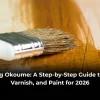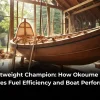There’s a moment in every boat builder or fine furniture maker’s project when you step back and admire the naked wood. If you’re working with Okoume plywood, that moment is special. The wood has a warm, pinkish-salmon hue, a silky-smooth grain, and a lightweight strength that feels both delicate and incredibly resilient. But this beauty is raw, vulnerable to the elements, and it’s the finish you choose that will transform it from a project into a legacy piece.
Welcome to your definitive guide to finishing Okoume marine plywood. Whether you’re crafting a elegant kayak, a stunning piece of modern furniture, or restoring a classic dinghy, the steps you take now will define your creation for years to come. We’re diving deep into the three most popular finishing systems for 2026: the crystal-clear armor of epoxy, the rich, protective glow of varnish, and the bold, opaque statement of paint. We’ll walk through this process together, step-by-step, with a human touch, because woodworking isn’t just about the destination—it’s about the joy of the journey.
Why Okoume Deserves Your Best Effort
First, let’s appreciate the canvas. Okoume plywood isn’t your average sheet goods. Sourced from the Gabon region in Africa, it’s renowned in the marine world for its excellent strength-to-weight ratio and its ability to bend gracefully. True Okoume marine plywood uses waterproof adhesives and high-quality veneers, making it resistant to delamination. However, its relatively soft surface and open pores mean it soaks up moisture like a sponge if left unprotected. This isn’t a flaw; it’s a call to action. By sealing it properly, you’re not just adding a layer; you’re locking in its inherent beauty and ensuring its longevity. A trip to a well-stocked woodworking supplies store will reveal that Okoume plywood is a premium product, and it deserves a premium finish to match.
The Foundation: Preparation is Everything
No matter which finish you choose, the foundation is non-negotiable. Skipping prep work is like building a house on sand.
- Sanding: The Meditation of Woodworking. Start with 80 or 100-grit paper to flatten any glue lines or minor imperfections. Progress methodically through 120, 150, and finally 180-grit. Always sand with the grain to avoid unsightly cross-grain scratches that will be magnified by a clear finish. This process raises the “nap” of the wood—tiny fibers that stand up. For a glass-smooth feel, after your first pass with 180-grit, lightly dampen the surface with a sponge. Let it dry, and the raised fibers will feel like sandpaper. Sand them off with 180 or 220-grit. This “de-whiskering” step is a pro secret for a flawless base.
- Dust Removal: An Obsessive’s Guide. After sanding, you must be fanatical about dust. Use a tack cloth, a vacuum with a soft brush attachment, and finally, wipe the entire surface down with a lint-free cloth dampened (not soaked) with mineral spirits or denatured alcohol. This will reveal any last-minute scratches and ensure a perfectly clean surface. A clean workshop and a dedicated woodworking supplies store tack cloth are your best friends here.
Pathway 1: The Crystal Clarity of Epoxy
Epoxy is the ultimate sealer and strengthener. It doesn’t just sit on top; it penetrates and bonds with the Okoume plywood, creating a hard, waterproof barrier. This is the go-to choice for the hull of a boat or any project facing harsh conditions.
- Step 1: Mixing with Precision. Epoxy is a two-part system. Follow the manufacturer’s instructions to the letter. The ratio of resin to hardener is a science, not a suggestion. Mix thoroughly for the recommended time, scraping the sides and bottom of your mixing cup. Inaccurate mixing is the primary cause of epoxy that never fully cures. For large projects like those using full sheets of Okoume marine plywood, consider a pump system that automatically dispenses the correct ratio.
- Step 2: The Application – Thin, Then Thick. Your first coat should be a “seal coat”—a thin layer often slightly diluted with a bit of denatured alcohol (if the product allows) to help it penetrate deeply into the Okoume plywood. Use a foam roller or a wide, soft-bristled brush to apply, then immediately “tip off” the surface by dragging a dry, high-quality brush lightly across it to pop any air bubbles and smooth the finish.
Once the seal coat is tacky (following product recoat times), you can apply subsequent fill coats. These are applied neat to build thickness and fill the grain. Multiple thin coats are always better than one thick, runny coat. - Step 3: Sanding the Epoxy. Once fully cured, epoxy will have a wavy, orange-peel texture. To achieve a flat, glass-like surface, you must sand it. Start with 120-grit to knock down the high spots, then progress through 220, 320, and even 400-grit for a perfectly smooth base. This is a dusty job, so wear a respirator. You now have a perfectly sealed piece of Okoume marine plywood that can be left as a durable satin finish or used as a base for varnish.
Pathway 2: The Warm Glow of Varnish
Varnish is what gives wood that deep, warm, “yacht-quality” glow. But varnish has limited waterproofing on its own. That’s why the golden rule is: Varnish always goes over epoxy. The epoxy seals, and the varnish provides UV protection and aesthetic beauty.
- Step 1: Choosing Your Varnish. Visit your trusted woodworking supplies store and you’ll find polyurethanes, spar varnishes, and newer hybrid formulas. For outdoor use on Okoume plywood, a high-quality spar varnish with UV inhibitors is essential to prevent the wood from darkening or the epoxy from yellowing.
- Step 2: Application is a Ritual. Varnish likes warm, dry, and dust-free conditions. Thin your first coat according to the instructions (usually about 10% with the recommended thinner) to help it bond to the epoxy. Apply with a high-quality, natural bristle brush. Don’t overload the brush. Flow the varnish on in long, smooth, overlapping strokes. Resist the urge to go back over it too much.
After each coat cures, lightly scuff-sand the entire surface with 320-grit sandpaper or a synthetic sanding pad. This creates “tooth” for the next coat to adhere to. Wipe away all dust with a tack cloth. For a truly mirror-like, professional finish, aim for 5-8 coats.
Pathway 3: The Bold Statement of Paint
Maybe the natural look of the Okoume plywood isn’t for you, or you need a specific color. Paint offers complete color uniformity and robust protection, hiding the wood grain beneath a durable skin.
- Step 1: The Critical Primer. You cannot paint directly onto raw wood or epoxy. For raw Okoume plywood, use a high-quality wood primer. If you are painting over the epoxy-sealed surface we created earlier, you must use a primer specifically designed to adhere to epoxy. This is a crucial step many miss, leading to peeling paint down the line. Your local woodworking supplies store can recommend the right primer for your system.
- Step 2: Painting for a Perfect Finish. After priming and sanding smooth, you’re ready for topcoats. Marine-grade polyurethane paints are incredibly durable. Use a foam roller to apply a thin layer and then immediately “tip” it with a dry brush, just like with epoxy, for a smooth finish. Alternatively, for the absolute flattest finish, consider spraying. Multiple thin coats will always yield a better, more durable result than one or two thick ones.
Your Partner in Craft: AEW Woods
As you embark on your project, the quality of your materials is paramount. This is where AEW Woods comes in. For decades, AEW Woods has been a trusted name for woodworkers and boat builders seeking premium materials. They are specialists in high-quality, genuine Okoume marine plywood, ensuring you get a product that is true to its name and performance standards. When you source your Okoume plywood from a reputable supplier like AEW Woods, you are starting your project with a foundation of quality, giving you the confidence that your meticulous finishing work will stand the test of time. They understand the needs of discerning craftspeople and are more than just a woodworking supplies store; they are a resource.
Also Read- Okoume Timber Explained: The Lightweight Hardwood Revolution in Woodworking
Conclusion
Finishing a project built from beautiful Okoume plywood is one of the most rewarding phases of the build. It’s where you see the material truly come to life, its character enhanced and its future secured. Whether you choose the rugged transparency of epoxy, the classic elegance of varnish, or the modern solidity of paint, the key lies in patience, preparation, and using the right techniques and high-quality materials from a trusted source like AEW Woods.
Remember, the finish isn’t just a coating; it’s the story you tell about your craft. It’s the protective shell that will carry your creation through sun, rain, and the simple passage of time. So take a deep breath, trust the process, and give your Okoume marine plywood the magnificent finish it deserves. Here’s to your masterpiece in 2026 and beyond.
Frequently Asked Questions (FAQs)
- Can I just use varnish directly on Okoume plywood without epoxy?
While you can, we strongly advise against it. Varnish alone is not a sufficient moisture barrier for the porous Okoume marine plywood. Moisture will eventually seep through microscopic pinholes in the varnish film, leading to dark spots, blistering, and rot. The epoxy-varnish system is the professional standard for a reason. - How long should I wait between coats of epoxy or varnish?
This is entirely product-dependent. Always follow the manufacturer’s instructions on the can. A general rule is that epoxy can be recoated after it becomes tacky (usually 4-8 hours) or after it’s fully cured (24 hours) and sanded. For varnish, recoat times are typically longer, often 8-12 hours, with light sanding between each coat. - What’s the best way to avoid air bubbles in my epoxy?
Mix slowly to minimize introducing air, use a foam roller for application, and always “tip off” the surface with a dry brush. Warming the epoxy components slightly before mixing can also reduce viscosity and help bubbles rise out more easily. - I need to buy all my materials. Is my local big-box store enough?
For a project of this caliber, a specialty woodworking supplies store or a marine chandlery is a far better choice. They will carry the specific, high-performance epoxies, UV-stable varnishes, and marine-grade paints that a project using Okoume plywood requires. - Why is my varnish finish sticky or not drying hard?
This is usually caused by improper conditions: high humidity, low temperatures, or applying the coat too thickly. It can also be due to contamination on the surface before application. Ensure you are working in a warm, dry environment and applying thin, even coats.






